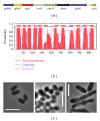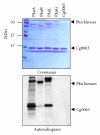Cytoskeletal proteins of actinobacteria
- PMID: 22481946
- PMCID: PMC3296230
- DOI: 10.1155/2012/905832
Cytoskeletal proteins of actinobacteria
Abstract
Although bacteria are considered the simplest life forms, we are now slowly unraveling their cellular complexity. Surprisingly, not only do bacterial cells have a cytoskeleton but also the building blocks are not very different from the cytoskeleton that our own cells use to grow and divide. Nonetheless, despite important advances in our understanding of the basic physiology of certain bacterial models, little is known about Actinobacteria, an ancient group of Eubacteria. Here we review current knowledge on the cytoskeletal elements required for bacterial cell growth and cell division, focusing on actinobacterial genera such as Mycobacterium, Corynebacterium, and Streptomyces. These include some of the deadliest pathogens on earth but also some of the most prolific producers of antibiotics and antitumorals.
Figures


Similar articles
-
The conserved actinobacterial transcriptional regulator FtsR controls expression of ftsZ and further target genes and influences growth and cell division in Corynebacterium glutamicum.BMC Microbiol. 2019 Aug 5;19(1):179. doi: 10.1186/s12866-019-1553-0. BMC Microbiol. 2019. PMID: 31382874 Free PMC article.
-
Signature proteins that are distinctive characteristics of Actinobacteria and their subgroups.Antonie Van Leeuwenhoek. 2006 Jul;90(1):69-91. doi: 10.1007/s10482-006-9061-2. Epub 2006 May 3. Antonie Van Leeuwenhoek. 2006. PMID: 16670965
-
[Advances in actinobacterial proteomics].Sheng Wu Gong Cheng Xue Bao. 2014 Jul;30(7):1044-58. Sheng Wu Gong Cheng Xue Bao. 2014. PMID: 25346979 Review. Chinese.
-
Marine actinobacteria: an important source of bioactive natural products.Environ Toxicol Pharmacol. 2014 Jul;38(1):172-88. doi: 10.1016/j.etap.2014.05.014. Epub 2014 Jun 4. Environ Toxicol Pharmacol. 2014. PMID: 24959957 Review.
-
Actinobacterial Flora in Feces of Healthy Cottontail Rabbits (Sylvilagus auduboni).Probiotics Antimicrob Proteins. 2015 Mar;7(1):9-13. doi: 10.1007/s12602-014-9179-x. Probiotics Antimicrob Proteins. 2015. PMID: 25424303
Cited by
-
¡vIVA la DivIVA!J Bacteriol. 2019 Oct 4;201(21):e00245-19. doi: 10.1128/JB.00245-19. Print 2019 Nov 1. J Bacteriol. 2019. PMID: 31405912 Free PMC article. Review.
-
Cell envelope of corynebacteria: structure and influence on pathogenicity.ISRN Microbiol. 2013 Jan 21;2013:935736. doi: 10.1155/2013/935736. Print 2013. ISRN Microbiol. 2013. PMID: 23724339 Free PMC article.
-
Cell division in Corynebacterineae.Front Microbiol. 2014 Apr 10;5:132. doi: 10.3389/fmicb.2014.00132. eCollection 2014. Front Microbiol. 2014. PMID: 24782835 Free PMC article. Review.
-
Developmental biology of Streptomyces from the perspective of 100 actinobacterial genome sequences.FEMS Microbiol Rev. 2014 May;38(3):345-79. doi: 10.1111/1574-6976.12047. Epub 2013 Nov 19. FEMS Microbiol Rev. 2014. PMID: 24164321 Free PMC article. Review.
-
Competition between DivIVA and the nucleoid for ParA binding promotes segrosome separation and modulates mycobacterial cell elongation.Mol Microbiol. 2019 Jan;111(1):204-220. doi: 10.1111/mmi.14149. Epub 2018 Nov 11. Mol Microbiol. 2019. PMID: 30318635 Free PMC article.
References
LinkOut - more resources
Full Text Sources

